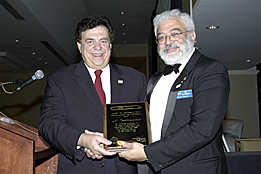Obituary
Remembering Lindsay Ingram, 1925 - 2014
 A tireless champion of the history of electrification in Manitoba, and an ambassador for IEEE, Lindsay Ingram passed away on November 5, 2014.
A tireless champion of the history of electrification in Manitoba, and an ambassador for IEEE, Lindsay Ingram passed away on November 5, 2014.
Graduating in electrical engineering from Heriot Watt College, Edinburgh, in 1944, he began his career as a night school lecturer at West Ham Technical College, near London. Following the war, he spent four years with the Kuwait Oil Company in the Persian Gulf before moving to Canada in 1951.
He joined what was then the Manitoba Hydro-Electric Board in 1952, retiring as Director of the System Planning Division, Manitoba Hydro, in 1984. He then became Interim Director of the High Voltage DC Research Centre in Winnipeg, providing leadership in its fledgling stages. During his tenure (1986-87), the Centre embarked upon many key initiatives, including work on a real-time digital simulator that became a success internationally.
Since then, Lindsay was no less busy as a volunteer. He spearheaded creation of the Manitoba Electrical Museum and Education Centre, persuading Manitoba Hydro and other sponsors to donate space and artifacts. He also initiated preparation of artifact descriptions.
"The growth of this museum was principally Lindsay's doing," said Prof. Aniruddha (Ani) Gole from the University of Manitoba. "He collected and documented information on Manitoba Hydro projects that raised living standards and quality of life in Manitoba, and surrounding Western Canadian regions."
The Nelson River High Voltage Direct Current (HVDC) Transmission System and the Pinawa Hydroelectric Power Project were the two most ground-breaking of these projects. Along a 100-km stretch of the Nelson River close to where it empties into Hudson Bay, there was huge potential for hydro-electric generation. The challenge was how to transport the power some 900 km south to the bulk of the province's population, concentrated in the greater Winnipeg area. The solution, completed in 1972, was high voltage direct current (HVDC) lines that had significantly lower losses than conventional AC transmission.
The Pinawa facility, located about 100 km northeast of Winnipeg, began operation in 1907. It was the first year-round hydroelectric plant in Manitoba, and one of the first anywhere to be developed in such a cold climate. Constructed by the Winnipeg Electric Railway Company, its primary load was a 35-vehicle street car system. Lindsay Ingram described the challenges the project faced in an article published in the Summer 2008 issue of the IEEE Canadian Review: “··· very little was known about construction in the northern wilderness - or the effects of frazil ice [loose, randomly oriented needle-shaped crystals] on the operation of a plant this size ···”.
Lindsay's enthusiasm for the importance of these projects was infectious. Serving as Vice-Chair of Winnipeg Section's Life Member affinity group, he inspired others to join him in the careful research that led to successful Milestone nominations for both: Nelson River was dedicated in 2005, and Pinawa was dedicated in 2008. "Lindsay was the major thrust of these Milestone initiatives," said Ani Gole.

Lindsay Ingram (second from right) at the 2005 Milestone dedication of the Nelson River High Voltage Direct Current (HVDC) Transmission System. From far left: Leonard Bateman, Bob Brennan, Bill Kennedy, Lindsay Ingram, Ani Gole.
In 2011, Lindsay was recognized by IEEE Canada with the E.F. Glass Medal, its service award for members in western Canada. The citation reads "In recognition of service to the power industry, and contributions to the IEEE milestone program."
Through the Milestone dedications Lindsay helped raise the profile for the organization worldwide. "I travel extensively as part of my employment," said Ani. "Engineers who I meet all over the world are aware of these two milestones. It is truly amazing how well known they are."
But it wasn't just the history of the province Lindsay was concerned about, according to Ani. "He had many bits of wisdom and advice to pass on to the next generation of young engineers that came in contact with him - throughout his long and distinguished career."
Lindsay's generosity of spirit extended to the community where he raised his family. He volunteered with the Victoria Hospital Life-Line, a Winnipeg service organization that helps seniors remain living in their homes. With an unquenchable intellectual curiosity, he was keen to encourage this in others, serving as a high school science fair judge.
A person of immense energy and passion, his passing is a deep loss to the entire engineering profession.
Contributed by Bruce Van-Lane, IEEE Canadian Review, with material from Sandra Ingram.
Remembering George Sagi, 1925 - 2015
 George Sagi, September 27, 1925 - January 7, 2015 It is with great sadness we announce the sudden passing of George Sagi. He is mourned by his wife Edith, of 63 years, his grandsons George (Kathleen), William (Lhen), and great-grandson Dean. George was predeceased by his beloved daughter Susan who passed away in October of 2014. George was born in Hungary and was educated there as an electronic engineer. In 1957 he moved to Canada with his wife and daughter and obtained his Master of Science degree at the University of Manitoba. George worked for the City of Winnipeg as an electronic engineer and head of the City's Communications Branch. During his career he wrote and contributed to several scientific publications. He was an active member of the Association of Professional Engineers and American Association of Traffic Engineers. George had a very creative mind that resulted in several patents. He retired from his position with the City after 30 years of dedicated service and devoted his free time to writing, with several books published. George and Edith spent many winters in Florida where they had a second home. Family and friends were always welcomed. George was a loving husband, father and grandfather. He took great pleasure in helping to raise his grandchildren. He was an extremely hard-working and passionate person who cared deeply for his family, friends and the world around him. A celebration of George's life will be held at Thomson "In the Park" Funeral Home, 1291 McGillivray Boulevard, on Wednesday, January 14 at 2:00 p.m.
George Sagi, September 27, 1925 - January 7, 2015 It is with great sadness we announce the sudden passing of George Sagi. He is mourned by his wife Edith, of 63 years, his grandsons George (Kathleen), William (Lhen), and great-grandson Dean. George was predeceased by his beloved daughter Susan who passed away in October of 2014. George was born in Hungary and was educated there as an electronic engineer. In 1957 he moved to Canada with his wife and daughter and obtained his Master of Science degree at the University of Manitoba. George worked for the City of Winnipeg as an electronic engineer and head of the City's Communications Branch. During his career he wrote and contributed to several scientific publications. He was an active member of the Association of Professional Engineers and American Association of Traffic Engineers. George had a very creative mind that resulted in several patents. He retired from his position with the City after 30 years of dedicated service and devoted his free time to writing, with several books published. George and Edith spent many winters in Florida where they had a second home. Family and friends were always welcomed. George was a loving husband, father and grandfather. He took great pleasure in helping to raise his grandchildren. He was an extremely hard-working and passionate person who cared deeply for his family, friends and the world around him. A celebration of George's life will be held at Thomson "In the Park" Funeral Home, 1291 McGillivray Boulevard, on Wednesday, January 14 at 2:00 p.m.
As published in the Winnipeg Free Press on January 10, 2015
Remembering Ivan Stojmenovic, 1957 - 2014
 Passing away on Nov. 3, 2014, Dr. Ivan Stojmenovic achieved recognition world-wide for his work in algorithms and protocols for data communications in wireless ad hoc and sensor networks.
Passing away on Nov. 3, 2014, Dr. Ivan Stojmenovic achieved recognition world-wide for his work in algorithms and protocols for data communications in wireless ad hoc and sensor networks.
But his passion and kindness made no less of an impression.
"He embraced the impossible in his own career, and instilled in his students a deep sense of confidence in themselves and their potential," said Dr. Rafael Falcon, a research scientist at Ottawa-based Larus Technologies Corporation, whose doctoral Photo credit: University of Ottawa studies were supervised by Prof. Stojmenovic at the University of Ottawa. "Knowing he trusted you and saw value in you as a researcher dispelled fears and insecurities that naturally arise in the early stages of graduate school life."
Ivan's brilliance in mathematics was evident from an early age, when he was awarded a Bronze Medal at the International Mathematics Olympiad for high school students in 1976. He received his B.Sc. and M.Sc. at the University of Novi Sad, and Ph.D. at the University of Zagreb, in Yugoslavia. He worked as a professor at universities in Yugoslavia, Japan, and USA, before joining the University of Ottawa in 1988, where he became a full professor, and continued his visiting-professor appointments and collaborations worldwide. A Canadian Serbian, his extensive international engagements made him truly a citizen of the world.
Ivan's scientific achievements made him revered by both his colleagues and those under his tutelage. "He will be remembered as a man of excellence," Rafael said. "He also never ceased to encourage and challenge his students to become stronger scholars and researchers themselves."
He received a Royal Society (UK) Wolfson Research Merit Award in 2006, supporting his Chair and Professorship of Applied Computing at the University of Birmingham. Ivan was elected IEEE Fellow in 2008 for "contributions to data communication algorithms and protocols for wireless sensor and ad hoc networks." From 2010-2011, he was IEEE Communications Society (ComSoc) Distinguished Visitor. In 2012, he was honoured with a Distinguished Service Award from IEEE ComSoc, Communications Software Technical Committee. That same year, he was elected Fellow of the Canadian Academy of Engineering, and Member of the Academia Europaea. Also in 2012, he was a recipient of a Humboldt Research Award, Germany. His most recent accolade was inclusion in the Thomson Reuters list of Highly Cited Researchers for 2013.
Ivan also left his mark in scientific publishing. He was founder of three journals: Ad Hoc & Sensor Wireless Networks: An International Journal; International Journal of Parallel, Emergent, and Distributed Systems; and, Journal of Multiple-Valued Logic and Soft Computing. For the latter, in 2002, he was awarded a Certificate of Appreciation, IEEE Computer Society, for his "outstanding contribution" as a founding managing editor. Most recently, he was steering committee member of IEEE Transactions on Emergent Topics in Computing, and editor of: IEEE Network; IEEE Transactions on Cloud Computing; and, IEEE Transactions on Computers, amongst others. From 2010-2013 he was editor-in-chief of IEEE Transactions on Parallel and Distributed Systems. He published more than 300 research papers, and edited seven books with John Wiley & Sons on wireless, ad hoc, sensor and actuator networks and applied algorithms.
Ivan chaired and/or organized more than 60 workshops and conferences, and served on more than 200 program committees. He was program co-chair at IEEE PIMRC 2008, IEEE AINA-07 and IEEE MASS-04&07. He founded several workshop series, and was workshop chair at IEEE ICDCS 2013, IEEE INFOCOM 2011, IEEE MASS-09 and ACM Mobihoc-07&08.
Even with his dizzying pace of research and volunteer activity, Ivan constantly extended himself personally to his students.
"There were many acts of kindness and displays of affection," Rafael recalls. "He outfitted a new international student with winter boots and supplied a bag of groceries. His reminder we should bundle-up during a -35 Celsius cold snap. A cherished silver coin he gave to a postdoctoral fellow.
"Ivan shared with us those things that brought him joy, and so enriched our lives. His memorable stories of Yugoslavia. The delights of Indian food. His gentle handshake and warm smile. These things will accompany us for the rest of our lives."
Dr. Ivan Stojmenovic will be fondly remembered by students and colleagues, and by all those that knew him from the engineering and science community, both in Canada and abroad.
Contributed by Bruce Van-Lane, IEEE Canadian Review.
Remembering Anastasios(Tas) Venetsanopoulos, 1941 - 2014
 Dr. Anastasios Venetsanopoulos, recognized by IEEE Canada for both technical achievements and volunteer contributions, passed away on Nov. 17, 2014. Better known as "Tas," he had a long and distinguished career as Dean of Engineering at the University of Toronto and Vice-President of Research and Innovation at Ryerson University.
Dr. Anastasios Venetsanopoulos, recognized by IEEE Canada for both technical achievements and volunteer contributions, passed away on Nov. 17, 2014. Better known as "Tas," he had a long and distinguished career as Dean of Engineering at the University of Toronto and Vice-President of Research and Innovation at Ryerson University.
Tas's record of IEEE volunteer service spanned four decades. He was coordinator of Educational Activities for IEEE Toronto Section from 1974 to 1976, progressing to become Chair from 1977 to 1979. He then Chaired the IEEE Central Canada Council from 1980 to 1982. He Photo credit: Ryerson University led the Canadian Society for Electrical Engineering (CSEE) - a constituent member of the Engineering Institute of Canada -from 1983 to 1985. The organization was renamed the Canadian Society for Electrical and Computer Engineering (CSECE) in 1990.
"He was a pillar of volunteerism," said Dr. Mo El-Hawary (FIEEE), Professor at Dalhousie University, who succeeded Tas as CSEE President in 1986. "Tas was one of only a handful of volunteers who gave of their time to both CSEE/CSECE and IEEE Region 7, prior to the 1994 merger." Tas received the IEEE Third Millennium Medal for his outstanding volunteer contributions. He continued on as an IEEE volunteer, still serving as a member of the Digital Signal Processing Technical Committee of the IEEE Circuits and Systems Society until last November.
A strong supporter of scientific publishing, Tas served from 1981 to 1983 as Editor-in-Chief of the Canadian Electrical Engineering Journal (CEEJ), predecessor to IEEE Canada's current Canadian Journal of Electrical and Computer Engineering. He served a second term as CEEJ co-Editor-in-Chief in 1988, and was guest editor for several IEEE journals.
Tas was also a prolific author, acclaimed internationally for his research in digital communications, multimedia systems, and biometrics and neural networks. He published more than 850 papers and has nine books to his credit. Citations of his work exceed 10,000 research paper references, and more than 400 text book references.
 Tas Venetsanopoulos receives the 2003 McNaughton Award from Mo El-Hawary, IEEE Canada President, 2002-2003. The award was presented during Toronto Section's Centennial Banquet.
Tas Venetsanopoulos receives the 2003 McNaughton Award from Mo El-Hawary, IEEE Canada President, 2002-2003. The award was presented during Toronto Section's Centennial Banquet.
Photo credit: Bob Alden.
His technical achievements were recognized by IEEE Canada's McNaughton Gold Medal in 2003 for "outstanding contributions to the design and implementation of communication systems, digital filters and multimedia systems; IEEE; the engineering profession and society at large."
There were many other accolades over the decades. He was a Fulbright Scholar (1965) and Schmitt Scholar (1978). He was elected Fellow of the Engineering Institute of Canada (1980), IEEE (1987), the Canadian Academy of Engineering (2001) and the Royal Society of Canada (2010).
Tas's impact in the Canadian academic community is profound. Completing his Ph.D. in Electrical Engineering from Yale University in 1969, he had joined the University of Toronto's Department of Electrical Engineering the year before. He was promoted over the years from lecturer to professor, and then assigned various senior administrative positions within the Department. From 2001 to 2006, he led the Faculty of Applied Science & Engineering as its 12thDean. He remained with the Faculty's Department of Electrical and Computer Engineering as Professor Emeritus upon taking on a new position outside of the University in 2006.
Tas joined Ryerson University as the founding Vice-President of Research and Innovation in 2006. According to Ryerson, external research funding doubled under his leadership and the university's research ranking moved into the top half of non-medical universities in Canada.
Despite an extraordinary level of professional activity throughout his career, Tas still found time to mentor more than 160 graduate students and postdoctoral fellows. In 2013, he was honoured by the Toronto Chapter of the American Hellenic Educational Progressive Association (AHEPA) with its Celebrating Excellence in Greek Achievement (CEGA) Award for Education.
Tas was highly respected by peers, colleagues and students around the world. He will not only be remembered for his vast contributions to the field of engineering, but for his warm smile and kind manner. He will be greatly missed.
Contributed by: Vawn Himmelsbach, freelancer writer; Bruce Van-Lane, IEEE Canadian Review.






